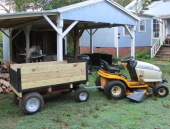for some reason i lost half of my previous post, i know this is become an awfully long post, but im posting it anyway. probably nobody will actually take the time to read this, but even if one person finds something valuable in it its worth putting it out there. -----------------------------------------------------------------------------------------------------
Third is the use of a set of design principles. My problem at first was that every writer has its own. from Holmgren to Mollison, from Lawton to Whitefield, i keep finding others. Ofcorse many of them are the same but phrased different, also Holmgren tends to be much more conceptual (making it more easy to use them for anything else that a garden system). In the end i like the ones being used by the dutch teachers as they are very
concrete and practical. I know this is becoming a very long piece of text and i noticed that doesnt work well on fora or websites, bút i will put them here.
I am really interested which principles others have been using (if they have). And i would be very interested in compiling examples in this thread of hów to apply them.
1.
Encourage and work with natural succession In anual monoculture every year your ecology is set back to its pioneer stage, costing you lots of work. In
permaculture we try to encourage your ecosystem to evolve, guiding every stage of succession to be in our advandage with species that serve functions for us and their surroundings.
2.
Increase diversity The more diversity the more resilient your system is, if any part fails or doesnt give you a crop, others will. Also it is about creating resilient systems of species that mutually support each other. the number of relationships between species or other elements counts. Building guilds is a good example of this principle in action.
3.
Every (important) element should serve many functions The most used example as i know it is a
chicken. But also the fruit tree, it can supply food, shade, bird-habitat, fire-wood, takes nutrients from deep layers and makes those available with leaf-litter. Another one is to not only use a legumes for food, but also provide nitrogen for surrounding plants that might need that, attract insects, and i think they can be really pretty when flowering
4.
Every (important) function should be supported by many elements Functions like fertilizing, electricity, providing for food or your water-supply, should always be served by as many elements as you can think of. Again when one fails the others will continu. for
water, apart from maybe being connected to 'the net' you coul reside to collecting rain-water, natural
wells, filtering your own grey-water etc.
5.
Focus on (local) organic recources For example in stead of synthetic fertilizers using
compost or (hu)manure, waterflow to create electrity, biogas for coocking, and for building
cob,
straw, clay
wood could be great local, renewable recources.
6.
Catch, store and recycle energy on the spot If using hedgerows to redirect winds, it is a small step to put turbines where you are directing it to.
Trees are also great energy traps. rainwater can be used for washing, after being
led through a living machine (organic purification) and used as drinking water after.
7.
Efficient energy planning Zoning your plot in how often you visit it and placing the elements according to that is a good example. Another is from a friend who has an
outhouse, he put different elements that need care several times of the on the route to the outhouse, in one walk to the toilet he takes the kitchen scraps to the compost (turns the compost if necessary) does a little weeding in his herb garden, maybe picks some small fruit that is ripe and checks on the (plant)nursery.
8.
Stacking in space and time Stacking in space is well known, the forest garen the best example of trying to stack plants providing food growing in 7 different layers on a small piece of land. Less known is stacking in time. good examples are to put in lettuce and endive in at the same time. The salads will quickly grow into the space between the slow growing endive (this space is unused potential), by the time you are harvesting your lettuce the endive will need that space and grow big.
9.
Relative location When placing elements think about their relative location. How does it interact with other elements on your site, would it be advantageous to place them next to each other, a
greenhouse next to your house? if you have nitrogen fixing plants, why not place them next to plants that consume lots of nitrogen?
10.
Increase the edge As is well known to ecologists edges are highly productive. the most famous example is the forest edge. the edge between field and forest, where species from both ecologies exist, plus species unique to the surroundings of an edge. Therefore ponds and garden beds are often designed in a way that increases the edge. But there are many more edges to consider, a tree, branching out up as well as down is the edge between (ground)water and air. Swales are ways to increase the edge, as are
coffee shops, where people interact.









 1
1





















